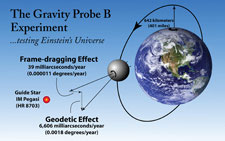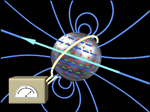WEEKLY HIGHLIGHTS FOR 19 NOVEMBER 2004:
GRAVITY PROBE B MISSION UPDATE

As of mission day #213, the GP-B spacecraft remains in good health and is continuing to perform well. We have been collecting science data for 83 days, and data acquisition process is proceeding as expected. The spacecraft is maintaining a constant roll rate of 0.7742 rpm (77.5 seconds per revolution), and it is flying drag-free around gyro #3. The Dewar’s internal temperature remains steady at just under 1.82 kelvin.
At this time of year, the spacecraft is entering a 3-week period where it remains
in full sunlight—that is, light from the Sun shines broadside on the
spacecraft. As a result, the Dewar’s outer shell has been warming up,
and some of this heat is transferred to the liquid helium inside. Because
the temperature and pressure inside the Dewar are maintained at constant
levels, this expected seasonal warming of the Dewar causes the helium inside
to boil off at a faster rate. To compensate for this increased helium flow
and maintain the correct pointing position, the spacecraft’s Attitude
and Translation Control system (ATC) has been “null dumping” (uniformly
venting) the excess helium out through the micro thruster system.

Last week, we reported that on 10 November 2004, the SQUID Readout (SRE) computer failed a fundamental "health check," which resulted in its rebooting itself and triggering six protective safemodes that, among other things, halted the spacecraft’s on-board timeline, unlocked the telescope from the guide star, closed the telescope shutter, and transitioned all four gyros into analog backup suspension. On first analysis, it appeared that the root cause of this anomalous event was that a high-energy proton had struck a critical memory location in the SRE computer during the severe geomagnetic storm that was raging all last week.
However, further analysis now suggests that the spacecraft did not suffer a new proton hit after all. Rather, the SRE computer had previously suffered high-energy proton hits resulting in multi-bit (not self-correctable) errors in two of its memory locations. These memory locations were thought to be non-critical, but it now appears that one of these affected memory locations was accessed during a routine maintenance procedure.


 This caused a ?health check? pf the SRE computer to fail, which in turn, automatically triggered the safemodes and re-booted the computer. For precautionary purposes, our team had already prepared a procedure to manually reboot the SRE computer and clear out any multi-bit errors, but this will no longer be necessary, since the computer?s self-reboot last week cleared and reset all of the computer?s memory locations. The fact that this event happened while the spacecraft was entering the South Atlantic Anomaly region of the Earth (where protection from proton bombardment is significantly reduced) during a severe geomagnetic storm, was apparently a coincidence.
This caused a ?health check? pf the SRE computer to fail, which in turn, automatically triggered the safemodes and re-booted the computer. For precautionary purposes, our team had already prepared a procedure to manually reboot the SRE computer and clear out any multi-bit errors, but this will no longer be necessary, since the computer?s self-reboot last week cleared and reset all of the computer?s memory locations. The fact that this event happened while the spacecraft was entering the South Atlantic Anomaly region of the Earth (where protection from proton bombardment is significantly reduced) during a severe geomagnetic storm, was apparently a coincidence.
Events such as the one that occurred last week always prompt a number of inquiries about whether such glitches cause any loss of scientific data or detriment to the experimental results. The short answer to this question is "no." Such events typically do not—and have not—had any significant effect on the GP-B experimental data or the results. To see why this is so requires a general understanding of how we collect data from the spacecraft, how safemodes work, and in general, how we process and analyze the data. We will cover all of these topics in upcoming GP-B updates.
Drawings & photos: The diagram of the GP-B experiment and the drawings of the SQUID Readout (SRE) circuitry and SQUID functionality, as well os the photo of a SQUID are all from the GP-B Image Archives here at Stanford. The drawing of solar radiation bombarding the Earth was taken from the NOAA/SEC Web site Home page. Click on the thumbnails to view these images at full size.
Please Note: Until further notice, we intend to continue posting these GP-B highlights on a weekly basis. Also, from time to time, we may post special reports and special updates, as warranted by mission events.
SWISS AMATEUR ASTRONOMER PHOTOGRAPHS GP-B GP-B SPACECRAFT IN ORBIT WITH GUIDE STAR IM PEGASI
To the right, is a thumbnail of a photograph of the GP-B spacecraft in orbit, along with the guide star, IM Pegasi. (Click on the thumbnail to view the photo at full size.) The photo was taken and emailed to us by Stefano Sposetti, a Swiss physics teacher and amateur astronomer. Stefano used a 40cm newtonian telescope, with a CCD camera and 20mm wide field lens attached to make this photo. He then sent us the two versions shown — the normal (black sky) version on the right, and an inverse version in which the constellation, Pegasus, the guide star IM Pegasi, and the path of the GP-B spacecraft are highlighted for easy identification on the left.

We are grateful to Stefano for sending us this wonderful photo. You can view other astronomical photos that he has taken on his Web page: http://aida.astronomie.info/sposetti. Following is Stefano's description of his photo:
In this picture one can see the quite dim GP-B satellite traveling from North (up) to South (down) direction. The bold line in the right part of the left image represents the satellite trail just before entering the earth shadow. (Every satellite becomes visible because it reflects the sunlight). The connecting lines show the constellation Pegasus. The small circle around the star is IM Pegasi, the guide star used by the spacecraft's telescope in his experiment! GP-B is a circumpolar satellite following a free fall trajectory about 640km above the earth surface. From my location the satellite passed that night at a maximum elevation of 87degrees, thus not exactly overhead. The brightness of the satellite was between 3mag and 4mag. The Moon, about in the last quarter phase, illuminated the sky and was a drawback for having a good signal/noise ratio of the satellite trace. I took this 60-seconds black and white CCD picture with a 20mm,f/2.8 lens on august 6 centered at 01:19:00 UT. North is up, East is left.
More links on recent topics
- Track the satellite in the sky
- Photo, video & and news links
- Build a paper model of the GP-B Spacecraft
- Following the mission online
- Our mailing list - receive the weekly highlights via email
- The GP-B Launch Companion in Adobe Acrobat PDF format. Please note: this file is 1.6 MB, so it may take awhile to download if you have a slow Internet connection.
Previous Highlight
Index of Highlights
